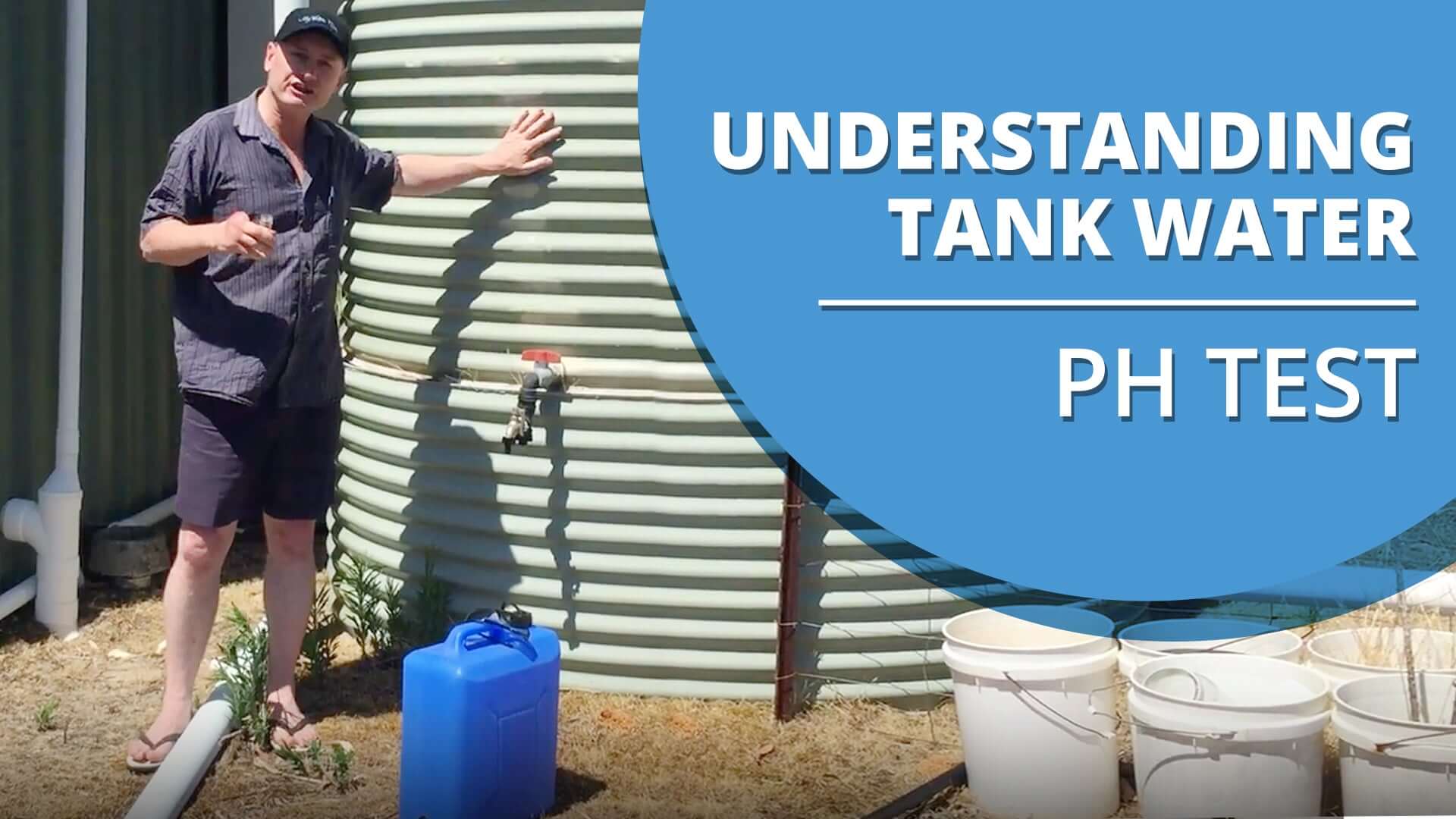In this article, we will cover everything you need to know when it comes to rainwater. We will also show you how to test the pH of rain water alongside the risks associated with directly consuming water from a rainwater tank.
Table of Contents
Immature Water
In Australia, we have rainwater that lands on the roofs of sheds, travels down the gutters, through the pipes and into the water tank.
This water, which is controlled by the sun, is evaporated from the ocean or the land, hits the clouds, creates rain, then drops on top of the roof. This is called immature water.
Mature Water
Mature water is rainwater at the end of its cycle. It has landed on the ground at an acid pH of about 6.
The water soaks into the earth and picks up minerals. Water molecules remember everything they ever come in contact with, in their existence.

Once it filters through the ground, it will eventually resurface and end up coming out of a spring. That's what we should be consuming — beautiful spring water! Clean, healthy, full of minerals and with the right pH level.
With rainwater tank water, we have trapped the water prematurely. It hasn't gone through the earth, so it's not ready for us to drink yet.
In this case, the government hasn't got their hands on it, so it’s not full of chlorine and fluoride. Moreover, it’s not contaminated by urban living and city corporations.
Afterwards, we can capture it on the roof and funnel it into a tank. The rainwater tank shown in the video holds water at about 5.5 pH, which is too acidic for people to drink regularly.
What’s Wrong with Rain Water?
It's acidic. The pH of rain water is usually somewhere between 5 and 6.5 pH, at the absolute best.
If you store your water in a concrete tank, the lime will leech out of the walls of the concrete tank and elevate the pH of the water.
If you do a pH test, the rain water pH level will probably be 7, so it’s getting back to neutral. The lime leaching out of the concrete will make the water neutral.
As human beings, we need to be consuming water at a pH level of 7, so it makes sense that the water flowing through the home should be at a pH level of 7.
If you see green/blue staining on your basin, that means acidic water is going through a copper pipe, and it's eating the soluble copper away — that's what the green colour on your basin is.
pH Level of Acid Rainwater
The pH level of normal rainwater is typically 5.5 to 6. If you’re using a concrete tank, the rainwater pH value is likely 7, so you pass this test.

When rainwater is stored in an AquaPlate tank (steel on the outside, plastic on the inside), or in tanks made of fibreglass, poly or large steel liners, there’s nothing in those materials that changes the water or adds minerals to raise the pH—so the water will remain acidic.
What Happens if You Continuously Consume Acidic Water?
When you consume acidic water, the water can take up to three weeks to go through your body. While the water is travelling through your body, your body works very hard to bring it back to a pH level of 7. This process can strip your body of precious minerals and leave you feeling less than optimal for weeks/months, or even years.
Other Risks Include:
Exposure to Contaminants
Metals and minerals present in acidic water can include iron, copper, manganese and zinc. This is due to them being dissolved in your water as result of touching copper pipes, your roof or gutters.
Exposure to too much of these metals may lead to illness and poisoning. Acidic water can also have a metallic and unsavoury taste, which isn’t exactly what you want from the water you drink.
Teeth Damage
Acidic water can accelerate the corrosion of your teeth and damage the gums.
Risks for Young Children
Elevated levels of metal contaminants found in acidic water can cause plenty of health issues that could prove fatal or debilitating for children. Vomiting, diarrhoea, kidney disease, liver disease, stomach cramps and nausea are among the leading health issues caused by the consumption of acidic water.
Water System and Pipework Damage
Due to the high acidic level in the water, plumbing can get damaged and corroded. It can even dissolve the copper right off the pipes.
Calcium Malabsorption
Calcium is important for the ongoing nourishment of your bones. But when you consume acidic water, your body has a reduced capacity to absorb calcium efficiently.
Gastrointestinal Distress
The leaching of metals from acidic water often leads to a gastrointestinal upset. Whenever you are overexposed to zinc residue from pipes, you can get nausea, diarrhoea and vomiting. You can also get these symptoms because of overexposure to copper.
Increased Exposure to Contaminants
When large water bodies have a pH level that is too high or too low, contaminants can increase. This increase in contaminants can lead to disease-causing bacteria, parasites and elevated ammonia levels.
Prolonged consumption of acidic water can lead to common health issues, including gout or arthritis, to name a few.
How to Add Mineral and Raise the pH Level of Rain Water

The best course of action to treat acidic water is to use a Whole House Rain Water Tank Filter System with Ultraviolet Light & Positive Charged Water Magnet and a Whole House pH Elevation System.
Rain Water Filter
A rain water filter will treat bugs, bacteria and other microscopic organisms, but it won’t solve acidic water.
There are two different types of water filters: gravity-fed and pump-fed. So be sure to talk to us about what your setup is.
Once the water is in the house, we recommend an under sink water filter at the very least to remove the bugs, in the off chance your UV light stops working due to an electrical short, blown bulb or other power issues.
pH Elevation System
A pH elevation system will solve the problem of acidic water by adding mineral to the water and elevating the pH.
If you’ve got a concrete tank, you will not need a pH elevation vessel, but we highly recommend at least a Twin Rain Water Filter to take care of the bugs and bacteria.
If you have steel, plastic, colourbond or anything other than concrete, then the water will not interact with the tank and will remain acidic. In this case, we recommend a pH elevation system.
Get Your Water pH Tested
Before you decide what your complete home setup should be, you need to test the water in your tank.
To find out the pH level of your rain water, you can use a pH test kit.
Simply run 15 millilitres into the pH tester, and consult the colour chart to get a reading. You’re looking for a pH minimum of 7 to be able to drink the water.
Conclusion
IF YOUR WATER IS UNDER 7 PH, ADD MINERAL!
Once there is mineral added to the water, it’s good to drink, your appliances will last longer and the pipework in your home will love you for it.
If you have purchased any of the products mentioned in this article and require any further assistance with their installation, please contact us.
Immature and Acidic Nature of Tank Rainwater: Rainwater collected from roofs and stored in tanks ("immature water") is typically acidic, with a pH between 5 and 6.5. Unlike "mature water" which filters through the earth and picks up minerals, tank water bypasses this natural process, remaining acidic and potentially stripping essential minerals from the body if consumed regularly.
Risks of Acidic Rainwater and Contaminants: Consuming acidic tank water can lead to mineral depletion in the body, teeth damage and gastrointestinal distress. It can also corrode plumbing, leading to increased exposure to dissolved metals like copper, iron, manganese and zinc, which can cause illness, poisoning and health issues in children. Acidic water can also promote the growth of disease-causing bacteria and parasites.
Solutions for Safe Rainwater Consumption: To make tank water safe for drinking, it's crucial to address both its acidity and potential microbial contamination. This involves using a Whole House Rain Water Tank Filter System with Ultraviolet Light & Positive Charged Water Magnet for bug and bacteria removal and a pH Elevation System to add minerals and bring the water's pH closer to neutral (7 pH). Concrete tanks may naturally elevate pH due to lime leaching, but still require filtration for microbial safety.
Hear from Our Satisfied Customers
What Is 'Immature Water' and Why Is it a Concern for Rainwater Tank Users in Australia?
'Immature water' refers to rainwater collected directly from roofs and stored in tanks. It hasn't undergone the natural filtration process of soaking through the earth and picking up minerals, which typically happens when rainwater becomes 'mature water' and resurfaces as spring water. This means tank rainwater is often acidic (pH 5-6.5) and lacks essential minerals, making it potentially unhealthy for regular consumption as your body has to work harder to neutralise it.
What Are the Main Health Risks Associated with Directly Drinking Acidic Rainwater from a Tank?
Continuously consuming acidic rainwater can lead to several health issues. Your body expends significant effort and strips precious minerals to neutralise the water. Other risks include teeth corrosion, exposure to dissolved metals (like copper, iron, manganese, zinc) from pipes and roofs, which can cause illness, poisoning and be particularly harmful to young children. It can also reduce your body's capacity to absorb calcium and may lead to gastrointestinal upset.
Besides pH Adjustment, What Other Treatment Is Recommended for Rainwater from a Tank before Consumption?
Even if the pH is corrected, rainwater from a tank can contain bugs, bacteria and other microscopic organisms. Therefore, it's highly recommended to use a Whole House Rain Water Tank Filter System, ideally with Ultraviolet (UV) Light and a Positive Charged Water Magnet, to treat these contaminants. Additionally, an under sink water filter provides an extra layer of protection for drinking water in case the main UV light system encounters issues.









![[VIDEO] Differences between filtering Rainwater vs Town and City Water](https://cdn.shopify.com/s/files/1/0455/8071/4143/files/2c4b15c01ce99186537cfea14687290c_600x_7689beef-804c-4be5-9ed9-7ec72f5d3aae_550x.jpg?v=1748912335)
